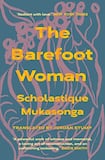
Nearing the end of The Barefoot Woman, Scholastique Mukasonga recounts a nightmare that’s plagued her sleep: piles of skeletons on the floor of a church. The bones belong to victims of the 1994 genocide in Rwanda. The author’s entire family, Tutsis, were wiped out in Nyamata, on the Burundi border, a place of dislocation and exile to which they had been banished many years before.
This is a memoir of life in that “place of the bleakest sterility.” It harks back farther, “Back before all that, back ‘in Rwanda’ – as Stefania liked to say.” Stefania was the author’s mother, who once charged her daughters: “When I die, when you see me lying dead before you, you’ll have to cover my body.”
Mukasonga was never able to fulfil that solemn duty. And so in this book she covers her mother with words (in French, translated by Jordan Stump). In so doing, the author wrests Stefania and others from the obliteration of the mass grave, the anonymous heap of bones, to memorialise the dead and the passion with which they had clung to their lives.
Stefania fought to save her children from “a death that an incomprehensible fate had planned out” – forever devising means of escape for them. She set about building a traditional Rwandan inzu for her family, “because she knew it was only in the ancestral dwelling place that she’d find the strength and courage she’d need to face our misfortunes”.
The phrase “in Rwanda” recurs throughout this elegiac memoir, laden with nostalgia for a disappeared way of life. “There are precious few houses like Stefania’s left in Rwanda today. Now they’re in museums, like the skeletons of huge beasts dead for millions of years.”
In gentle, loving detail and with many joyful passages, Mukasonga reconstructs Stefania’s Rwanda. The importance of cows, the “special dignity” of sorghum, the missionaries in contention with tradition, the rituals, marriage, and notions of beauty. It was a community in which “no one was ever definitively condemned: redemption was always possible”. Stefania and her ilk were Mother Courage figures, keepers of a fire that must never go out. And Mukasonga herself is a keeper of the fire.










